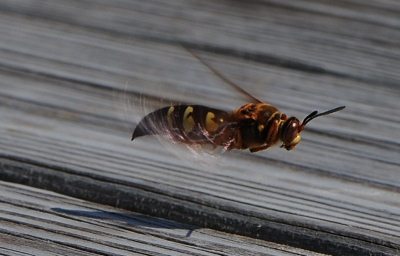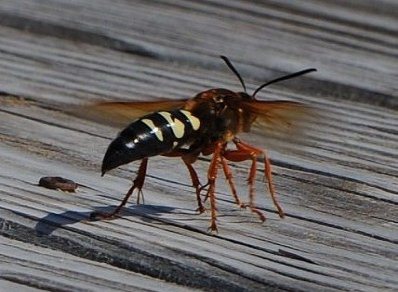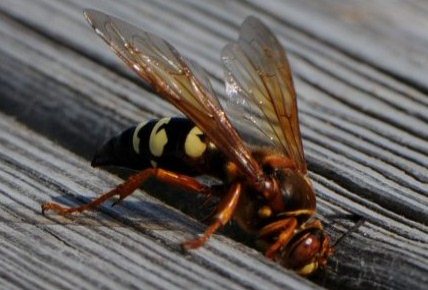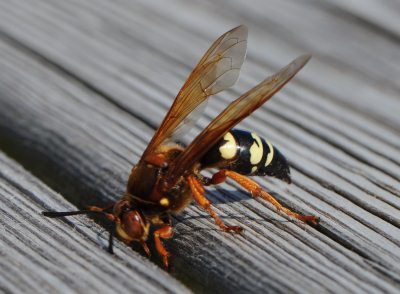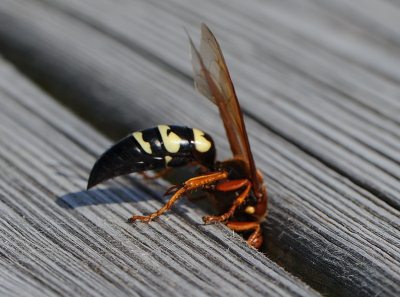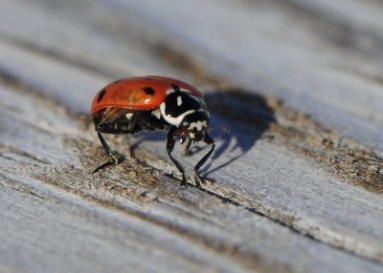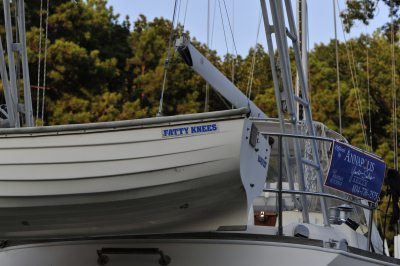Cicada Killers

|
Eastern Cicada Killer
A new one on us is the Jumbo Jet of the insect world, many have made their home around the pool here at the marina, and after chores on Beez we love to go and watch their antics whilst taking a dip. The cicada killers are huge, solitary wasps in the family Crabronidae. The name may be applied to any species of crabronid which uses cicadas as prey, though in North America it is typically applied to a single species, Sphecius speciosus, often simply referred to as "the cicada killer". However, since there are multiple species of related wasps, it is more appropriate to call it the eastern cicada killer. This species occurs in the eastern and midwest U.S. and southwards into Mexico and Central America. They are so named because they hunt cicadas and provision their nests with them. In North America they are sometimes called sand hornets, although they are not hornets, which belong to the family Vespidae. The most recent review of this species' biology is found in the posthumously published comprehensive study by noted entomologist Howard Ensign Evans.
Inbound. Landing gear down
Landed. Now to find a gap big enough to squeeze through
Far easier coming out of a knot hole or remembering which gap you fit down. Description: Adult eastern cicada killer wasps are large, half an inch to two inches long, robust wasps with hairy, reddish and black areas on the thorax (middle part), and are black to reddish brown marked with light yellow stripes on the abdominal (rear) segments. The wings are brownish. Coloration may superficially resemble that of yellowjackets or hornets. The females are somewhat larger than the males, and both are among the largest wasps seen in the Eastern United States, their unusual size giving them a uniquely fearsome appearance. European hornets (Vespa crabro) are often mistaken for Eastern cicada killers.
No. OK so spin round and try the other way
round
Life cycle and habits: Solitary wasps (such as the eastern cicada killer) are very different in
their behaviour from the social wasps such as hornets,
yellowjackets,
and paper
wasps. Cicada killer females use their sting to paralyse their prey
(cicadas)
rather than to defend their nests. Adults feed on flower nectar
and other plant sap
exudates. Adults emerge in summer, typically beginning around late June or early
July and continuing throughout the summer months. They are present in a given
area for 60 to 75 days, until mid-September. The large females are commonly seen
in mid-to-late summer skimming around lawns seeking good sites to dig burrows
and searching shrubs and trees for cicadas. The males are more often seen in groups, vigorously challenging one
another for position on the breeding aggregation from which they emerged, and
generally pursuing anything that moves or flies within proximity. It is not
unusual to see two or three male wasps locked together in midair combat, the
aggregate adopting an erratic and uncontrolled flight path until one of the
wasps breaks away. The male wasp's aggressive behavior is extremely similar to
that of another robust insect of the area, the male carpenter
bee. In both cases, while the males' vigorous territorial defense can
be extremely frightening and intimidating to human passersby, the males pose no
danger whatsoever. They will only grapple with other insects, and cannot
sting. This ground-burrowing wasp may be found in well-drained, sandy soils to loose clay in bare or grass-covered banks and hills as well as next to raised sidewalks, driveways and patio slabs. Females may share a burrow, digging their own nest cells off the main tunnel. A burrow is six - eight inches deep and about an inch and a half wide. The female dislodges the soil with her jaws and pushes loose soil behind her as she backs out of the burrow using her hind legs, which are equipped with special spines that help her push the dirt behind her. The excess soil pushed out of the burrow forms a mound with a trench through it at the burrow entrance. Cicada killers may nest in planters, window boxes, flower beds or under shrubs, ground cover, etc. Nests often are made in the full sun where vegetation is sparse.
The cicada killer above came in sounding like a B52, such a physical
effort to heft her prey, she had to rest on the pool
fence. After digging a nest chamber in the burrow, female cicada killers
capture cicadas, paralysing them with a sting; the cicadas then serve as food to
rear their young. After paralysing a cicada, the female wasp straddles it and
takes off toward her burrow; this return flight to the burrow is difficult for
the wasp because the cicada is often more than twice her weight. After putting
the cicada in the nest cell, the female deposits an egg on the cicada and closes
the cell with dirt. Male eggs are laid on a single cicada but female eggs are
given two or sometimes three cicadas; this is because the female wasp is twice
as large as the male and must have more food. New nest cells are dug as
necessary off the main burrow tunnel and a single burrow may eventually have 10
to 20 cells. The egg hatches in one or two days, and the cicadas serve as food
for the grub. The larvae
complete their development in about two weeks. Overwintering occurs as a mature
larva
within an earth-coated cocoon.
Pupation occurs in the nest cell in the spring and lasts twenty five to thirty
days. There is only one generation per year and no adults overwinter. So all
these hundreds we see around the pool will be gone just as we get back from the
UK, forever. This wasp is frequently attacked by the parasitic "velvet ant" wasp, Dasymutilla occidentalis, also known as the "cow-killer" wasp. It lays an egg in the nest cell of the cicada killer, and when the cicada killer larva pupates, the parasitoid larva consumes the pupa.
Interaction with humans: Although cicada killers are large, female cicada killer wasps are not aggressive and rarely sting unless they are grasped roughly, stepped upon with bare feet, or caught in clothing, etc. One author who has been stung indicates that, for him, the stings are not much more than a "pinprick". Males aggressively defend their perching areas on nesting sites against rival males but they have no sting. Although they appear to attack anything that moves near their territories, male cicada killers are actually investigating anything that might be a female cicada killer ready to mate. Such close inspection appears to many people to be an attack, but male and female cicada killers don't land on people and attempt to sting. If handled roughly females will sting, and males will jab with a sharp spine on the tip of their abdomen. Both sexes are well equipped to bite, as they have large jaws; however, they don't appear to grasp human skin and bite. They are non-aggressive towards humans and usually fly away when swatted at, instead of attacking. Cicada killers exert a natural control on cicada populations and thus may directly benefit the deciduous trees upon which their cicada prey feed.
We rescued a ladybird (didden as Bird called them when she was little) from the surface of the pool, it took a while for her to dry her wings, repack her chute and scuttle about her business
After our shower, a big fat bee
Walking through the yard, Bear was taken with a boat called 'Barefoot', more for her dinghy called 'Fatty Knees'. "Time for bed" said Zebedee
ALL IN ALL FASCINATING STRANGE LOOKING V BOMBERS |
